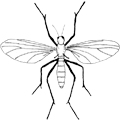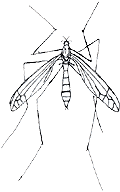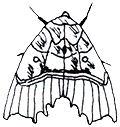Despite the absence of light, a variety of plants and animals are to be found underground and, although there are both natural and manmade sites, for the purposes of this section the term ‘cave’ will be used as an overall description. Not all parts of the cave are totally dark and it is usually divided into three distinct zones, viz:
ENTRANCE ZONE – the actual entrance to a tunnel or shaft which receives a normal amount of light.
THRESHOLD ZONE – the area inside the cave which still receives some light, however little. It also includes the base of a shaft where accidental cave dwellers can be found.
DARK ZONE – the area which never receives any light at all.
The presence (or absence) of light can determine the type of plant or animal that inhabits a particular place in a cave but there are also other factors such as temperature, air flow, humidity, food supply and even the time of year. There are three main groups of animals that inhabit caves, viz:
- Troclobite – an animal that lives permanently in a cave and is never found on the surface.
- Troclophile – an animal that usually lives in a cave, but can also be found on the surface.
- Trogloxene– an animal that regularly uses a cave for part of its life (one or two members of Kent Underground Research Group come into this category!). Most trogloxenes use a cave during winter for the purposes of shelter or hibernation.
Unlike their surface relatives, very little research has been carried out on cave animals and the one thing we know about them, is that we do not know very much at all! Members of the Group are carrying out research and would appreciate details of any sightings of plants or animals found in caves. The examples which follow are the ones most, likely to be found in Kent and Sussex. The common name has been used where possible but the Latin name appears where there is no other.
FUNGUS GNAT

– this small fly has a humped thorax and small spines on the leg joints. It is the nearest we have to a troglobite as its complete life cycle is spent underground. The white, dark-headed larva lives on minute fungi growing on cave walls and the pupa hangs from the roof before changing into a gnat. The only reason it cannot be called a true troglobite is because it can be found above ground, although possibly inhabiting animal burrows, holes in trees and cracks in rocks. It is very difficult to identify since there are about 500 different species of fungus gnat, although only a few are found underground.
FLIES

– In winter, animals resembling bees can sometimes be found hibernating in tiny holes in cave walls. These are actually harmless Drone Flies which rely on their resemblance to honey bee drones for protection. They breed on the surface and the larva is the ‘rat-tailed maggot’ found in stagnant water. During summer, several other species of fly can be found resting on cave wails such as the Caddis Fly and Crane Fly. It is still not known why they undergo this resting stage in their life cycle without food.
MOTHS

– The Tissue Moth and Herald Moth can often be found hibernating in the threshold and dark zones of a cave, sometimes so covered with droplets of condensation that they can hardly be seen. The larvae of both species are surface dwellers and it seems to be only the adults which venture underground. The Herald Moth has been known to spend up to 10 months in a cave and, since this cannot be solely hibernation, more research is needed to investigate this part of its life cycle.
BUTTERFLIES

– Most species hibernate on the surface in the egg, larva or pupa stage but some can be found in the threshold zone hibernating as adults. The most common species is the Peacock but the Small Tortoiseshell and Comma are also found. The Red Admiral and Painted Lady have been found trying to hibernate but there is no evidence of them succeeding, although they could possibly do so during a mild winter.
SPIDERS

– The species known as Meta merianae can be found in the entrance and threshold zones but its close relative, Meta menardi, is a true cave spider from the dark zone. This is an attractive, shiny looking spider and its egg sacs can often be seen hanging from the roof. In recent years, experts have found a slightly different variety called Meta boumeti but it is very difficult to tell them apart.
FOXES – A sand mine at Greenwich is home to a number of foxes which leave their distinctive smell and droppings as evidence. Where the roof fails prevent us from going any further, the foxes have made their own system of tunnels into what must be a very extensive and safe lair.
BATS – Over the last 50 years the bat population of Britain has declined drastically and this is believed to have been caused by modern farming methods, use of pesticides and disturbance of their roosting/hibernation sites. Some species, such as the Horseshoe Bats, have disappeared completely from Kent and Sussex where they were once common. Caves are very important to many species of bat and, although breeding roosts are usually on the surface, one mine in Kent is known to be used occasionally for this purpose. Mating occurs in autumn but fertilization is delayed until the spring, with only one offspring a year except for occasional twins. With declining numbers, it is important that each rearing is successful and any disturbance during this period is critical.
During winter their food supply declines and this means that bats have to hibernate to survive until spring. In late autumn they put on weight so that their fat reserves will last them for up to five months of hibernation, during which time their body temperature drops to nearly zero and their metabolism slows right down. Caves are used by many species for hibernation but only where the air flow, humidity and temperature are fairly constant. Bats can detect quite minute changes and will wake up to change their position in a cave or even fly to another site. Once a suitable cave site has been found, they crawl into a crevice (only some species hang upside down) and this is when problems can occur.
If they are disturbed, they slowly wake up as the body temperature rises and this uses up a surprising amount of energy. The heartbeat increases from 25 beats a minute to 1,000 when in flight and the valuable fat reserves are depleted with little hope of replenishment. Too many disturbances will mean that the fat reserves will not last the winter and they literally starve to death. In a state of hibernation bats are so torpid that they appear dead, but it takes very little to disturb them. Shining bright lights on the bats or even the heat of a person’s body in a confined space is sufficient to wake them up. It is thus vital that anyone finding a bat underground leaves immediately.
Bats are now a protected species under the Wildlife and Countryside Act 1981 and it is an offence to knowingly disturb a hibernating bat or block up the entrance to a roost. Special licences are granted by the Nature Conservancy Council to conservationists who monitor bat sites and even they are not allowed to visit sites more than three times over winter. The bat workers are part of a national group of volunteers who are building up a picture of the needs of bats so that ways can be found to help them. They work closely with groups such as KURG who use their equipment and expertise to take them into the underground sites. A voluntary code of practice has now been introduced to restrict winter visits to sites used by bats and it has been found that the reduced disturbance allows the bat population to increase. A particularly important site at the Westerham Ragstone Mine is gated and access strictly controlled.
The bat species found in this area are Brandts, Brown, Long Eared, Daubenton’s, Natterer’s, Pipistrelle and Whiskered. The KURG has a Bat Liaison Officer and he would welcome details of any sighting of bats underground. If you did not know in advance that bats were present at a site, you have no reason to worry about breaking the law so long as you leave the site immediately. Further details of bats and Bat Groups can be obtained by writing to KURG who will pass on the query.
FUNGI – The lack of light means that ordinary plants cannot survive in caves. Fungi, however, are perfectly equipped to live in the dark since they do not have chlorophyll and do not need light to manufacture food. They reproduce by spores and, when blown by the slightest current of air, will immediately start growing when they land on anything organic. This can be pit props, pieces of wood, dead insects, bat droppings or even an explorer’s discarded sandwich. They secrete enzymes which break down the organic material and this is absorbed by the plant. Some species send out long, thread-like filaments which, if they come across another food source, will break and form a separate plant. Some mines in Britain have been used to grow mushrooms commercially but, for some reason, attempts in the South East have never been successful.
Some underground fungi can grow into marvellous shapes and there are many different colours, the latter depending on the food source. One species hangs down from pit props to form a threadlike curtain and another forms jelly-like stalactites. In the Greenwich sand mine, a species grows on the fox droppings with thin filaments that stand upright. The most common form in Kent and Sussex sends out horizontal filaments similar to a spider’s web and these can sometimes cover the whole floor. Very little research has been carried out into cave fungi and identification is a specialist art. There are thousands of species of fungi in Britain and some adopt completely different shapes when growing underground.